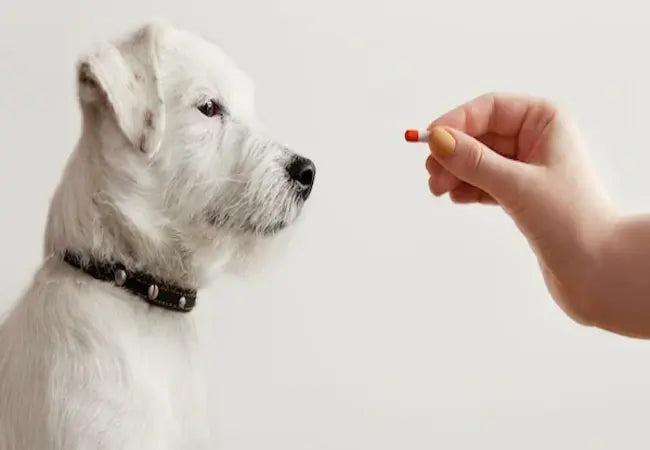Dangers of Topical Medications for Pets: A Vet’s 2025 Safety Guide 🩺

In this article
Dangers of Topical Medications for Pets: A Vet’s 2025 Safety Guide 🩺🐾
By Dr. Duncan Houston BVSc
1. Why Topical Products Aren’t Always Safe
Topicals—creams, ointments, gels, patches, soaps, flea/tick drops—may seem benign, but if licked, ingested, absorbed, or applied in excess, these can cause serious harm, ranging from gut ulcers and anemia to heart failure and seizures.
Pets' habits—chewing tubes, licking fresh application sites, or grooming treated areas—put them at risk.
2. Common Problem Ingredients & Effects
a) Zinc oxide
Found in sunscreen/diaper rash creams, ingested zinc oxide can damage red blood cells, causing anemia, weakness, pale gums, rapid breathing, dark urine and intestinal upset.
b) Retinoids
Anti-aging and acne topicals with retinoids (adapalene, tretinoin) can cause vomiting, lethargy, dry eye, birth defects if ingested or absorbed.
c) NSAIDs
Topical diclofenac, flurbiprofen, etc., may look mild but cause ulcers, severe GI upset, kidney damage in pets—even fatal.
d) Corticosteroids
Human creams like betamethasone/clobetasol may trigger PU/PD (urination/thirst), vomiting, and endocrine imbalance in pets.
e) Minoxidil
Hair-growth gels (Rogaine) can poison pets, causing heart failure—even small exposure can be lethal.
f) Fluorouracil & calcipotriene
Cancer creams containing 5‑FU have caused vomiting, seizures, bone marrow failure; calcipotriene can cause life‑threatening hypercalcemia, kidney failure.
g) Local anesthetics (‑caine)
OTC pain relief creams with benzocaine/lidocaine can lead to seizures, arrhythmias if ingested.
3. Risks from Veterinary Topicals
Even pet-intended products carry risk when misused:
- 🐾 Flea/tick drops (imidacloprid, permethrin, selamectin) – overdose or application to the wrong species (e.g., dog product on cat) may cause neurotoxicity, drooling, seizures, collapse ;
- 💊 Transdermal gels & patches—used for methimazole, fentanyl, etc.—can cause overdose if licked, eaten, or poorly absorbed ;
4. How Pets Are Exposed
- Chewing tubes, ripping open containers.
- Licking your skin after application (sunscreen, erectile dysfunction creams, etc.).
- Grooming treated areas or another pet’s fur.
- Ingesting leftover topical wipes or bandages.
5. Recognizing Signs of Topical Poisoning
Symptoms vary by substance but include:
- 🌡️ Gastrointestinal: vomiting, diarrhea, ulcers, blood in stool;
- 🧠 Neurological: seizures, tremors, ataxia;
- ❤️ Cardiovascular: arrhythmias, collapse (especially minoxidil);
- 🟥 Blood disorders: anemia (zinc oxide), bone marrow suppression (5‑FU);
- 🦴 Endocrine effects: PU/PD, liver/kidney damage;
- 🧴 Dermal: intense itching, irritation;
- 🐕 Behavioral: salivation, agitation, abnormal licking.
6. Immediate Steps if Exposure Occurs
- 🚫 Stop exposure—remove product or treated clothing immediately;
- 🧼 Rinse skin thoroughly with soap & water;
- 📞 Call your vet or poison control (ASPCA: 888-426-4435; Pet Poison Helpline: 855-764-7661);
- ⌚ If recent ingestion and safe, the vet may induce vomiting;
- 🧯 Bring product tube, patch, or ingredient list to clinic;
- 🩺 Follow veterinary advice—monitor at home for mild exposure or hospitalize for severe reactions.
7. Veterinary Treatment Methods
- 💧 IV fluids for dehydration;
- 🗑️ Activated charcoal to bind toxins;
- 🛡️ Gastroprotectants for ulcers;
- ⚕️ Symptomatic care—anti-seizure meds, heart support, respiratory assistance;
- 🧬 Bloodwork & monitoring: CBC, organ function tests;
- 🔁 Transfusion or chelation for heavy-metal poisoning.
8. Recovery & Prognosis
- 🟢 Mild exposures often resolve in 24–48 hrs with simple care;
- 🟠 Moderate cases need a few days of supportive treatment;
- 🔴 Severe poisoning (heart damage, seizures, toxicity) may cause lasting effects or death.
9. Prevention: Be Pet-Safe in 2025
- 🔒 Store all human/pet topicals in secure, high cabinets;
- 🧴 Wear gloves and wash hands post-application.
- 🚫 Prevent pets from licking treated areas—use an E-collar;
- 📜 Follow label directions and only use vet-approved products;
- 🐈⬛ Use species-appropriate formula and correct dosage;
- 🏷️ Talk to your vet about transdermal patch safety and absorption.
10. Ask A Vet Support & Resources
- 📱 Ask A Vet App – 24/7 emergency pet medicine support;
- 🎓 Webinars – guidance on safe topical use and poisoning prevention;
- 🛠️ Woopf & Purrz Safety Kits™ – include storage guides, E-collars, and emergency contacts.
11. Final Takeaway
Topicals are convenient but not harmless for pets. In 2025, protecting them means safe storage, correct use, and vigilance against grooming-treated skin. If exposure occurs, rinse first, call the vet fast, and follow committed treatment steps to safeguard your pet’s health 🐶❤️.
If you suspect exposure, visit AskAVet.com or open our app—immediate vet assistance is always within reach.


